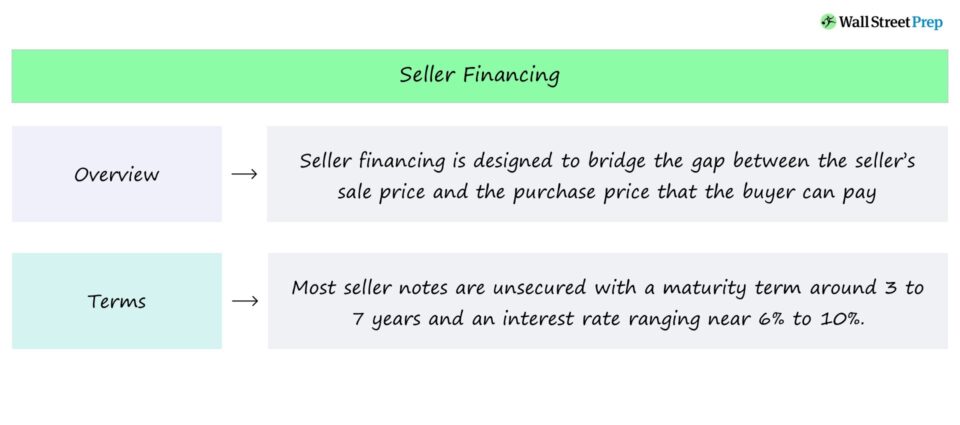What is Seller Financing?
Seller Financing, or a “seller note”, is a method for buyers to fund the acquisition of a business by negotiating with the seller to arrange a form of financing.

How Does Seller Financing Work in Real Estate
With seller financing, or “owner financing”, the seller of a business agrees to finance a portion of the sale price, i.e. the seller accepts a portion of the total purchase price as a series of deferred payments.
A significant portion of transactions involving the sale of homes and small to medium-sized businesses (SMBs) include seller financing.
Seller financing means the seller agrees to receive a promissory note from the buyer for an unpaid portion of the purchase price.
While less common in the middle market, seller financing does appear occasionally, but in far lower amounts (i.e. 5% to 10% of the total deal size).
Usually, the seller offers the financing if no other sources of funding can be obtained by the buyer and the transaction is on the verge of falling apart for that reason.
What is the Role of Seller Notes in Property Sales?
A seller note is designed to bridge the gap between the seller’s sale price and the amount that the buyer can pay.
However, there is substantial risk associated with providing financing to a buyer, especially since the seller is an individual with limited resources rather than an institutional lender.
The seller must carefully vet the buyer by requesting a credit report, calling personal references, or hiring a third party to run an in-depth background check.
If all goes well and the buyer fulfills all their debt obligations, the seller note can facilitate a quicker sale, despite the risk undertaken.
The process of applying for a bank loan can be time-consuming, only for the result to sometimes be a rejection letter, as lenders can be hesitant to provide financing to fund the purchase of a small, non-established business.
Seller Financing Lending Terms: Maturity and Interest Rates
A seller note is a form of financing wherein the seller formally agrees to receive a portion of the purchase price — i.e. the acquisition proceeds — in a series of future payments.
It is important to remember that seller notes are a type of debt financing, thus are interest-bearing securities.
But if there are other senior secured loans used to fund the transaction, seller notes are subordinated to those senior tranches of debt (which have higher priority).
Most seller notes are characterized by a maturity term of around 3 to 7 years, with an interest rate ranging from 6% to 10%.
- Maturity Term = 3 to 7 Years
- Interest Rate = 6% to 10%
Because of the fact that seller notes are unsecured debt instruments, the interest rate tends to be higher to reflect the greater risk.
Seller Financing in Real Estate: Lending Example
Suppose a seller of a home, i.e. the homeowner, has set the sale price of their house at $2 million.
- Home Sale Price = $2 million
An interested buyer was able to secure 80% of the total purchase price in the form of a mortgage loan from a bank, which comes out to a $1.6 million.
The buyer, however, only has $150k in cash, meaning there is a shortage of $250k.
- Mortgage Loan = $1.6 million
- Buyer Cash on Hand = $150k
- Buyer Shortage = $250k
If the homeowner decides to take the risk, the $250K gap in financing can be bridged through owner financing, typically structured as a promissory note (and the sale of the home could then close).
The seller and buyer will then negotiate the terms of the seller note and have them written out in a document that states the interest rates, scheduled interest payments, and the maturity date on which the remaining principal must be repaid.
Compared to traditional mortgages, seller financing tends to have higher down payments (~10% to 20%) and interest payments with shorter borrowing periods since the owner most likely does not want to be a “lender” for decades on end.
The Wharton Online and Wall Street Prep Real Estate Investing & Analysis Certificate Program
Level up your real estate investing career. Enrollment is open for the Feb. 10 - Apr. 6 Wharton Certificate Program cohort.
Enroll Today





